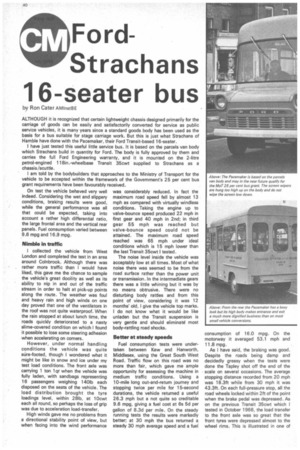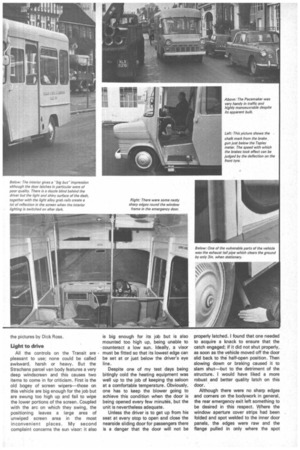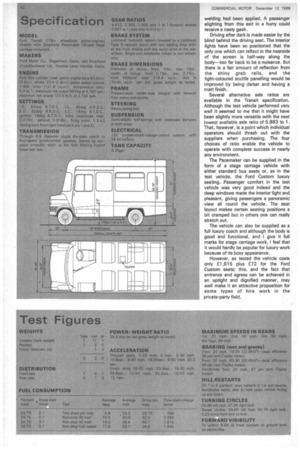Ford
Page 78

Page 79

Page 80

If you've noticed an error in this article please click here to report it so we can fix it.
Strachans 16-seater bus
by Ron Cater AMInstBE
ALTHOUGH it is recognized that certain lightweight chassis designed primarily for the carriage of goods can be easily and satisfactorily converted for service as public service vehicles, it is many years since a standard goods body has been used as the basis for a bus suitable for stage carriage work. But this is just what Strachans of Hamble have done with the Pacemaker, their Ford Transit-based 16-seater.
I have just tested this useful little service bus. It is based on the parcels van body which Strachans build in quantity for Ford. The body is fully approved by them and carries the full Ford Engineering warranty, and it is mounted on the 2-litre petrol-engined 118in.-wheelbase Transit 35cwt supplied to Strachans as a chassis /scuttle.
I am told by the bodybuilders that approaches to the Ministry of Transport for the vehicle to be accepted within the framework of the Government's 25 per cent bus grant requirements have been favourably received.
On test the vehicle behaved very well indeed. Considering the wet and slippery conditions, braking results were good, while the general performance was all that could be expected, taking into account a rather high differential ratio, the large frontal area and the vertical rear panels. Fuel consumption varied between 9.6 mpg and 16.9 mpg.
Nimble in traffic
I collected the vehicle from West London and completed the test in an area around Colnbrook. Although there was rather more traffic than I would have liked, this gave me the chance to sample the vehicle's great docility as well as its ability to nip in and out of the traffic stream in order to halt at pick-up points along the route. The weather was foul and heavy rain and high winds on one day proved that one of the ventilators in the roof was not quite waterproof. When the rain stopped at about lunch time, the roads quickly deteriorated to a nasty slime-covered condition on which I found it possible to lose some steering adhesion when accelerating on corners.
However, under normal handling conditions the vehicle was quite sure-footed, though I wondered what it might be like in snow and ice under my test load conditions. The front axle was carrying 1 ton 1qr when the vehicle was fully laden, with sandbags representing 16 passengers weighing 140Ib each disposed on the seats of the vehicle. The load distribution brought the tyre loadings level, within 281b, at 10cwt each all round, so perhaps the loss of grip was due to acceleration load-transfer.
High winds gave me no problems from a directional stability point of view, but when facing into the wind performance was considerably reduced. In fact the maximum road speed fell by almost 13 mph as compared with virtually windless conditions. Taking the engine up to valve-bounce speed produced 22 mph in first gear and 40 mph in 2nd; in third gear 55 mph was reached but valve-bounce speed could not be attained. The maximum road speed reached was 65 mph under ideal conditions which is 15 mph lower than the last Transit 35cwt I tested.
The noise level inside the vehicle was acceptably low at all times. Most of what noise there was seemed to be from the road surface rather than the power unit or transmission. In the intermediate gears there was a little whining but it was by no means obtrusive. There were no disturbing body rattles and from this point of view, considering it was 12 months' old, I give the vehicle top marks. I do not know what it would be like unladen but the Transit suspension is very gentle and should eliminate most body-rattling road shocks.
Better at steady speeds
Fuel consumption tests were undertaken between Kew and Hanworth, Middlesex, using the Great South West Road. Traffic flow on this road was no more than fair, which gave me ample opportunity for assessing the machine in medium traffic conditions. Using a 10-mile long out-and-return journey and stopping twice per mile for 15-second durations, the vehicle returned a useful 26.3 mph but a not quite so creditable 9.6 mpg, giving a fuel cost at 6s 5d per gallon of 8.3d per mile. On the steady running tests the results were markedly better; at 30 mph the bus returned a steady 30 mph average speed and a fuel consumption of 16.0 mpg. On the motorway it averaged 53.1 mph and 11.8 mpg.
As I have said, the braking was good. Despite the roads being damp and decidedly greasy when the tests were done the Tapley shot off the end of the scale on several occasions. The average stopping distance recorded from 20 mph was 18.3ft while from 30 mph it was 43.3ft. On each full-pressure stop, all the road wheels locked within 2ft of the point when the brake pedal was depressed. As on the previous Transit 35cwt which I tested in October 1966, the load transfer to the front axle was so great that the front tyres were depressed almost to the wheel rims. This is illustrated in one of the pictures by Dick Ross. Light to drive
All the controls on the Transit are pleasant to use; none could be called awkward, harsh or heavy. But the Strachans parcel van body features a very deep windscreen and this causes two items to come in for criticism. First is the old bogey of screen wipers—those on this vehicle are big enough for the job but are swung too high up and fail to wipe the lower portions of the screen. Coupled with the arc on which they swing, the .positioning leaves a large area of unwiped screen area in the most inconvenient places. My second complaint concerns the sun visor: it also
is big enough for its job but is also mounted too high up, being unable to counteract a low sun. Ideally, a visor must be fitted so that its lowest edge can be set at or just below the driver's eye line.
Despite one of my test days being bitingly cold the heating equipment was well up to the job of keeping the saloon at a comfortable temperature. Obviously, one has to keep the blower going to achieve this condition when the door is being opened every few minutes, but the unit is nevertheless adequate.
Unless the driver is to get up from his seat at every stop to open and close the nearside sliding door for passengers there is a danger that the door will not be properly latched. I found that one needed to acquire a knack to ensure that the catch engaged; if it did not shut properly, as soon as the vehicle moved off the door slid back to the half-open position. Then slowing down or braking caused it to slam shut—but to the detriment of the structure. I would have liked a more robust and better quality latch on this door.
Although there were no sharp edges and corners on the bodywork in general, the rear emergency exit left something to be desired in this respect. Where the window aperture cover strips had been folded and spot welded to the inner door panels, the edges were raw and the flange pulled in only where the spot welding had been applied. A passenger alighting from this exit in a hurry could receive a nasty gash.
Driving after dark is made easier by the blind behind the driving seat. The interior lights have been so positioned that the only one which can reflect in the nearside of the screen is half-way along the body—too far back to be a nuisance. But there is a fair amount of reflection from the shiny grab rails, and the light-coloured scuttle panelling would be improved by being darker and having a matt finish.
Several alternative axle ratios are available in the Transit specification. Although the test vehicle performed very well it seemed to me that it might have been slightly more versatile with the next lowest available axle ratio of 5.883 to 1. That, however, is a point which individual operators should thrash out with the suppliers when purchasing. The four choices of ratio enable the vehicle to operate with complete success in nearly any environment.
The Pacemaker can be supplied in the form of a stage carriage vehicle with either standard bus seats. or, as in the test vehicle, the Ford Custom luxury seating. Passenger comfort in the test vehicle was very good indeed and the deep windows made the interior light and pleasant, giving passengers a panoramic view all round the vehicle. The seat layout makes certain seating positions a bit cramped but in others one can really stretch out.
The vehicle can also be supplied as a full luxury coach and although the body is good and functional, and I give it full marks for stage carnage work, I feel that it would hardly be popular for luxury work because of its boxy appearance.
However, as tested the vehicle costs only £1,615 plus £72 for the Ford Custom seats; this, and the fact that entrance and egress can be achieved in an upright and dignified manner, may well make it an attractive proposition for some types of hire work in the private-party field.
























































































































































